
© Railway Wonders of the World 2012-


The Forth Bridge (2)
A work which cost £3,000,000 and contains over 50,000 tons of steel
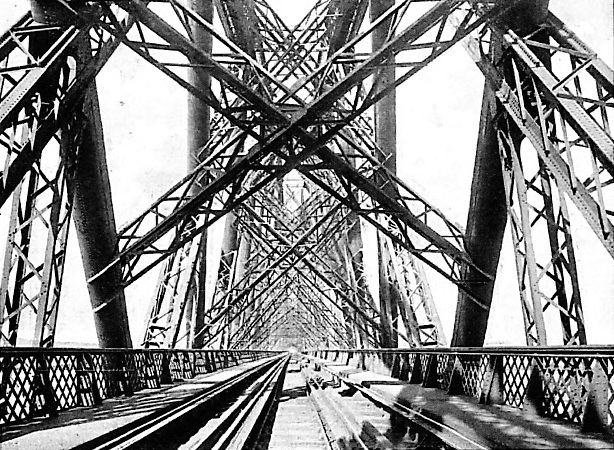
LOOKING THROUGH THE FORTH BRIDGE
ALTHOUGH the majority of engineering achievements in connection with British railways which were considered brilliant wonders in their day have been since outrivalled in other parts of the world, there is one piece of work which still stands supreme. This is the Forth Bridge, spanning that storm-
When railways commenced to grow and reached farther and farther out until at last they offered an east, coast route between London and the northernmost centres of Scotland, this wide estuary offered an insurmountable obstacle to continuous communication. As is well known, this way to the North runs via Newcastle and Edinburgh to Perth, Dundee, and points beyond. Prior to the bridging of the Forth a steam ferry plied across the estuary, but this was inconvenient, slow, and uncomfortable. The result was that travellers to Dundee favoured the west coast route via Carlisle, inasmuch as thereby through direct communication was available. An all-
This put the east coast route at such an overwhelming disadvantage that the North British Railway Company, which was the system most vitally affected, set out to obtain direct railway communication across the estuary. The matter became imperative, owing to the acute competition of the west coast route. The urgency of some such short cut across the water-
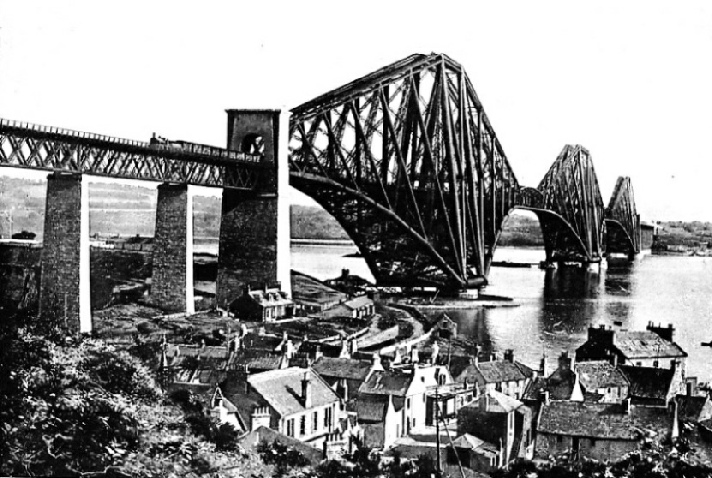
THE BIGGEST BRIDGE IN THE WORLD: THE FORTH BRIDGE, FROM NORTH QUEENSFERRY
The engineer succeeded in satisfying his supporters of the feasibility of such a structure, and the requisite parliamentary sanction was obtained in 1873, the Forth Bridge Company being formed, with a capital of £1,660,666, to complete the work. The contract was secured by Messrs. Arrol; but, unfortunately, several delays arose, which postponed the commencement of the task until 1879. At the time these delays were exasperating, but it was providential that they occurred. During the stormy night of Sunday, December 28th, 1879, the central part of Bouch’s other great work, the Tay Bridge, fell into the Tay while a passenger train was crossing from shore to shore. Of the seventy-
The extent of this catastrophe and the startling details which were revealed as a result of the subsequent inquiry brought public opinion antagonistic to Sir Thomas Bouch’s proposal for bridging the Forth. The Tay Bridge disaster, in a way, was fortunate, as there is no doubt but that, had it been completed, the Bouch Forth Bridge would have come down with the first heavy north-
Bridging the Forth appeared to be in danger of becoming numbered among the apparently impossible things when it was revived by Mr. Matthew William Thompson, the chairman of the Midland Railway. The latter was interested in the completion of the bridge, and a meeting of the directors of the North British, North Eastern, Great Northern, and Midland Railways was held at York to consider a co-
In spanning the Firth of Forth due regard had to be paid to the claims of navigation, which are considerable. The significance of this provision is more potent to-

PLAN AND ELEVATION OF THE BRIDGE
The details of the design were investigated thoroughly, and finally it was adopted as being the best possible solution of the problem. Messrs. Fowler and Baker were appointed as the engineers to the undertaking. With much difficulty, and in the face of severe opposition, the requisite Parliamentary Act was obtained in 1882, and at the end of that year the contract for erection was secured by Messrs. Tancred, Arrol, and Co, a firm incorporated especially for this task, and of which the late Sir William Arrol and Sir Thomas S. Tancred, a well-
The undertaking aroused the keenest interest throughout the world, not only from its immensity, but because of the cantilever design which was adopted. The principle, however, is by no means new -
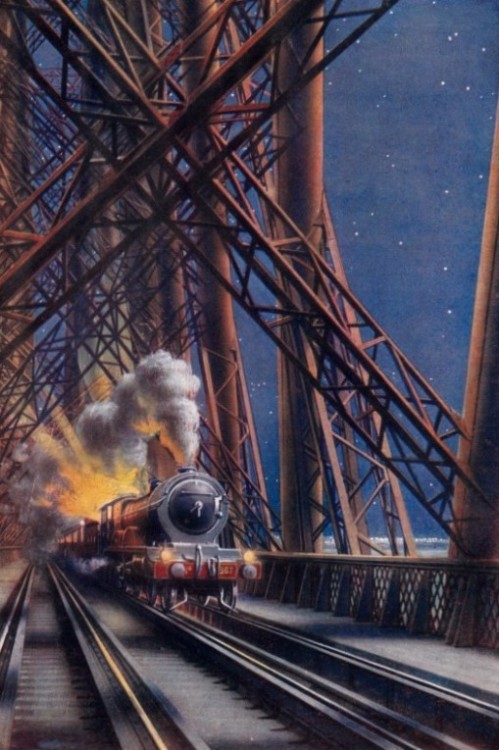 Not only did the new bridge eclipse anything previously attempted in these islands, but it was far and away more ambitious in its dimensions than anything hitherto completed in any other part of the world. Under these circumstances the engineers were deprived of precedents to guide them. Pioneering had to be carried out from beginning to end. Special devices, methods, and tools had to be evolved to cope with unusual conditions, and teasing problems had to be unravelled practically every day.
Not only did the new bridge eclipse anything previously attempted in these islands, but it was far and away more ambitious in its dimensions than anything hitherto completed in any other part of the world. Under these circumstances the engineers were deprived of precedents to guide them. Pioneering had to be carried out from beginning to end. Special devices, methods, and tools had to be evolved to cope with unusual conditions, and teasing problems had to be unravelled practically every day.
BRITAIN’S ENGINEERING TRIUMPH: THE FORTH BRIDGE.
This is the only bridge in the world across which a train can travel, with perfect safety, at the rate of 60 miles an hour.
The first move in actual construction was the erection of the approach viaducts, and simultaneously the piers for the cantilevers. These latter were placed respectively on the Queensferry and Fife shores, while the central pier was built on Inchgarvie Island. At each of these places there are four cylindrical piers, and for the most part they were built upon the pneumatic caisson method. The sea-
At the bottom of the caisson was a working chamber, 7 feet in height, where the excavators toiled, under compressed air. Admittance and egress were through the usual shafts and air locks. Owing to the character of the clay the caissons had to be sunk to depths ranging between 70 and 90 feet. At this depth the base of the piers is 70 feet in diameter, tapering gradually to 60 feet at low-
On Inchgarvie Island, as the subaqueous work had to be carried through rock to secure a level bench 70 feet below water, and as the caisson system just described was impracticable, owing to the slope of the rock, the base of the caisson was converted for the occasion practically into a huge diving-
From the centre of each pier rises a gigantic tube, or leg of steel, to a height of 343 feet. They do not rise vertically, but each broadside pair leans inwards. Thus at the base, looking through the length of the bridge, the tubes are 120 feet apart, but at the top they are 33 feet apart. These sloping columns are 12 feet in diameter, and at the base each sloping pair is connected by a horizontal tube of the same diameter. At the top the ends are connected by a box lattice girder, which likewise is 12 feet in depth. Additional strength is imparted by two diagonals formed of tubes 8 feet in diameter, thus imparting prodigious strength to the deepest part of the cantilever.
From either side of this central section, or panel, the arm of the cantilever springs to a distance of 680 feet from the pier. Each bottom member of the arms comprises a steel tube 12 feet in diameter where it rises from the “skew-
But, except on those sides where the shore cantilevers reach out to join the approach viaducts, the overhang, 680 feet, is not sufficient to bring the arms together. In fact, there was a gap of 380 feet over the channel on either side of Inchgarvie. This gap is closed with a girder 346 feet 6 inches long, 41 feet deep at the end, and 51 feet deep at the centre, and weighing 872 tons. It was built out from either end of the opposite arms, and connected together 150 feet above high water.
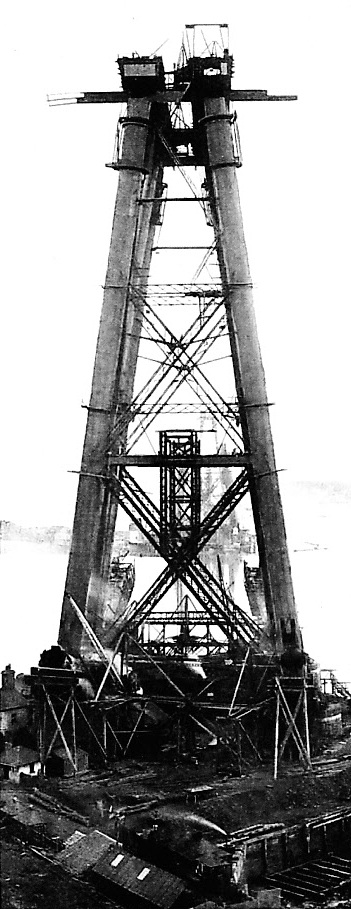 The cantilever is secured to the piers by the aid of bed-
The cantilever is secured to the piers by the aid of bed-
As might be supposed, the unique character and size of this bridge demanded the elaboration of special erecting methods. Practically speaking, the bridge was built twice: first piecemeal at the works on shore. The material was brought in its raw condition from the rolling mills to the contractors’ shops, and there fashioned to the required shape and design. Special machines were built to meet every phase of the work. There were large mandrels to which the plates were bent for the tubular parts of the fabric, huge hydraulic presses for bending the plates, furnaces for heating the metal, drilling machines, and so forth. At first attempts were made to bend the plates in their cold condition to the desired curve, but this proved impracticable, so that a careful heating method had to be adopted. Every piece was fitted to its neighbour on shore, and every rivet hole examined by the engineers before it was passed. If an additional rivet hole, were deemed necessary to make a good, sound job, the sanction of the engineers, who, metaphorically speaking, lived on the works, had to be obtained, and assent was not extended until its necessity had become fully recognised and it was found that the metal would not be weakened in the slightest degree by such action.
RAISING THE MASSIVE STEEL LEGS ON THE FIFE PIER, APRIL 15, 1887. These huge tubes tower to a height of 343 feet.
The engineers took no chances; they were resolved not to be surprised by the development of something unforeseen at an unexpected moment. It was these elaborate cautionary methods which enabled work to proceed steadily and persistently once it was commenced, and which eliminated those periodical in interruptions and hitches which often accompany under-
One instance of this decision to risk nothing may be related. At the time the work was in progress knowledge of the effect of wind pressure upon bridges of large size, the caprices of the wind, its action, and, more particularly, its force in the Firth of Forth, were somewhat hazy. On the island of Inchgarvie, which is exposed to the full brunt of a gale coming from the east, Sir Benjamin Baker set up some wind gauges, the records of which were observed carefully and frequently. One was of large size, measuring 20 by 15 feet. In the centre of this surface was placed a tiny gauge, resembling a door, with a superficies of about 2 feet, while it was flanked on either side by another gauge. On each shore other gauges were set up. Some very remarkable results were noticed. Thus when the large gauge was registering a pressure of 12 pounds per square foot it was found that the little gauge at the same time recorded as much as 23 pounds per square foot. This served to show that there is a tendency for the wind to act something after the manner of a jet of water. At other times, when the Inchgarvie gauge registered a pressure of 34 pounds per square foot, the shore gauges would show anything from 12 to 22 pounds per square foot, proving conclusively that the strongest blows come in puffs, or are felt over only a comp-
The setting of the steel likewise was carried out upon ingenious and novel lines. Scaffolding was impossible. Instead, in the case of the central section of each cantilever, the work was carried out from the base to the top by means of a vertically
travelling platform, whereon the handling machinery was placed; while cradles, or cages, were placed around the tubular columns for the riveters and their machines. The men were lifted and lowered by means of hoists and cages, similar to those employed in mines, so that the minimum of time was lost in getting from and to the working areas, while the material was handled with the maximum of expedition. So successful were these arrangements that the centre portion of the Queensferry cantilever was built up to its full height of 281 feet in about twenty-
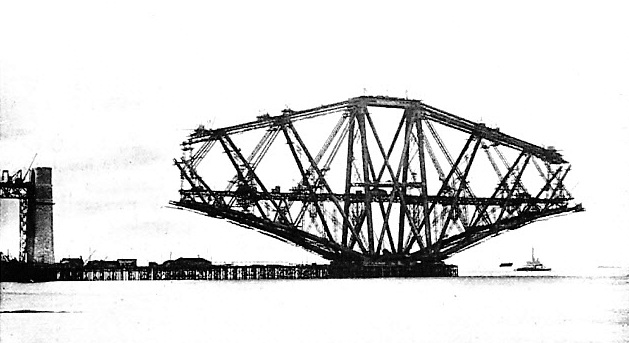
THE QUEENSFERRY MAIN PIER, NOV. 7, 1888.
The task of connecting up the arms of opposing halves of a span in such a huge structure as this is extremely delicate. A mass of steel, 855 feet in length, which represented one moiety from end to end, has a pronounced stretch under the action of the sun’s rays. The calculations necessary to enable connection to be accomplished with the minimum of delay were made, and the closing lengths, or key pieces, were carefully prepared. A cloudy day, when the temperature was equable, was selected for the task, and the breaches were closed in accordance with the prearranged plans, without the slightest hitch. Moreover, the details were prepared in such a manner as to enable the key piece to be completed, and the temporary connection to be cut away, in a few hours.
An interesting story in connection with this part of the work may he related. The task advanced more rapidly on the Queensferry than on the Fife bank, so that on September 26th, 1889, the two arms on the latter side were ready to be closed. There was a keen rivalry among the workmen on the opposite ends of the meeting arms to be first across the gap. Two men decided to steal a march upon their fellow workmen, and one of this twain was resolved not to share the glory with anyone if he could help it. The only thing was that he could not get rid of his colleague, who clung to his side. Suddenly a brilliant idea occurred to him. They had a ladder, that was just long enough to reach across the breach if only a rope could be obtained to lash it at one end. The second man, all unsuspectingly, hurried off to find a rope, but his comrade, should-
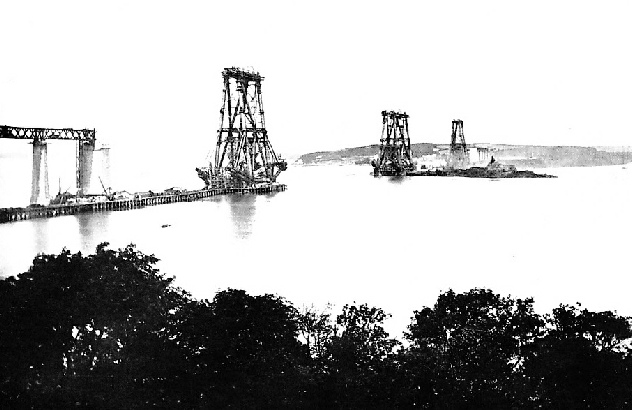
GENERAL VIEW OF THE FORTH BRIDGE FROM THE SOUTH SHORE OF THE WORKS, showing the three main piers, AUGUST 2, 1887.
The railway tracks are laid on a viaduct which runs through the cantilevers. There is a double road, with a gangway on either side for workmen. The bridge was subjected to severely exacting tests in February, 1890, under direction of the Board of Trade, from which it emerged triumphantly, the maximum deflection on the ends of the cantilevers of the main spans being only 7¾ inches and 1⅝ inches at the central girders. The following day a furious gale swept the Firth of Forth, but the bridge stood as firmly as a rock. The official opening took place on March 4, 1890, when King Edward VII, as Prince of Wales, drove the last rivet in the middle of the northern main girder.
By the time the structure had been completed some £3,000,000 had been expended, of which the bridge proper absorbed about £1,700,000, the plant and general charges some £800,000, and the connecting roads of railway £500,000. Over 54,000 tons of steel were worked into the fabric. The Inchgarvie piers support 18,700 tons, and the other two piers 16,130 tons each. To hold this mass of steel together, about 6,500,000 rivets, representing over 4,000 tons, were required, and 40 miles of steel plates were used for fashioning the tubes. In addition, 740,000 cubic feet of granite masonry, 46,300 cubic yards of rubble masonry, and 64,300 cubic yards of concrete, and over 21,000 tons of cement, were utilised. When work was in full swing an army of 5,000 men found employment, and so carefully were they tended, and so complete the precautions adopted to ensure their safety, that only fifty-
Yet, although the bridge is sufficiently strong to withstand a tornado, it is susceptible to the insidious ravages of an implacable enemy -
Seeing that the steel highway which carries the train is continuous for a length of 4,800 feet, there is a considerable movement of the metal under the fluctuations of temperature. The total allowance for expansion and contraction is 8 feet 4 inches, there being four expansion joints on each track of the cantilever sections.
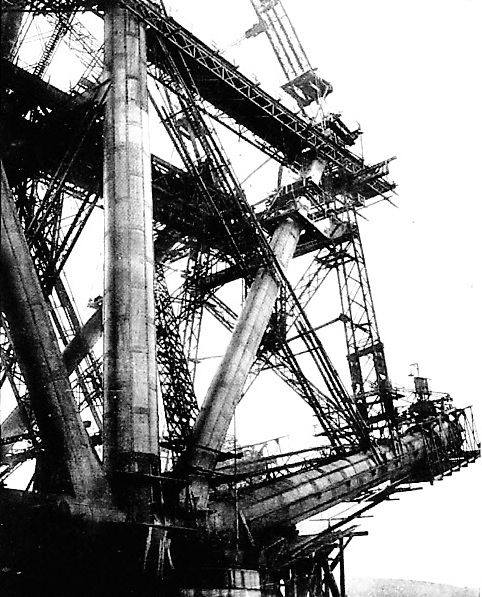
CREEPING OUT OVER THE WATER: THE MAIN PIER, DEC. 20, 1887.
Each arm has an overhang of 680 feet.
For twenty-
An attempt to eclipse this wonder of British engineering is being made in Canada, with a bridge which is to span the River St. Lawrence just above the City of Quebec; but this structure, taken on the whole, will not exceed the Scottish work except in one particular -
From the railway point of view the Forth Bridge has been a complete commercial success. It is worked and maintained by the North British Railway.
[From Part 9 of Railway Wonders of the World by Frederick A. Talbot, 1913]
You can read more on “Famous Viaducts”, “The Forth Bridge” and “Marvels of Engineering” on this website.